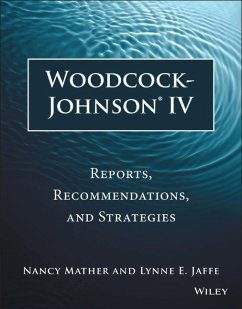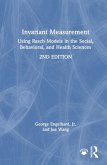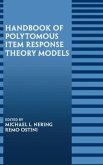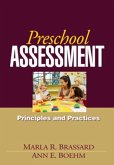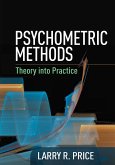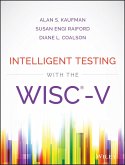- Broschiertes Buch
- Merkliste
- Auf die Merkliste
- Bewerten Bewerten
- Teilen
- Produkt teilen
- Produkterinnerung
- Produkterinnerung
Includes online access to new, customizable WJ IV score tables, graphs, and forms for clinicians Woodcock-Johnson IV: Reports, Recommendations, and Strategies offers psychologists, clinicians, and educators an essential resource for preparing and writing psychological and educational reports after administering the Woodcock-Johnson IV. Written by Drs. Nancy Mather and Lynne E. Jaffe, this text enhances comprehension and use of this instrument and its many interpretive features. This book offers helpful information for understanding and using the WJ IV scores, provides tips to facilitate…mehr
Andere Kunden interessierten sich auch für
![Frontiers of Test Validity Theory Frontiers of Test Validity Theory]() Keith A MarkusFrontiers of Test Validity Theory204,99 €
Keith A MarkusFrontiers of Test Validity Theory204,99 €![Invariant Measurement Invariant Measurement]() George Engelhard JrInvariant Measurement204,99 €
George Engelhard JrInvariant Measurement204,99 €![Handbook of Polytomous Item Response Theory Models Handbook of Polytomous Item Response Theory Models]() Handbook of Polytomous Item Response Theory Models109,99 €
Handbook of Polytomous Item Response Theory Models109,99 €![Preschool Assessment Preschool Assessment]() Marla R BrassardPreschool Assessment123,99 €
Marla R BrassardPreschool Assessment123,99 €![Psychometric Methods Psychometric Methods]() Larry R PricePsychometric Methods112,99 €
Larry R PricePsychometric Methods112,99 €![Designing Quality Authentic Assessments Designing Quality Authentic Assessments]() Tay Hui YongDesigning Quality Authentic Assessments206,99 €
Tay Hui YongDesigning Quality Authentic Assessments206,99 €![Intelligent Testing with the Wisc-V Intelligent Testing with the Wisc-V]() Alan S KaufmanIntelligent Testing with the Wisc-V97,99 €
Alan S KaufmanIntelligent Testing with the Wisc-V97,99 €-
-
-
Includes online access to new, customizable WJ IV score tables, graphs, and forms for clinicians Woodcock-Johnson IV: Reports, Recommendations, and Strategies offers psychologists, clinicians, and educators an essential resource for preparing and writing psychological and educational reports after administering the Woodcock-Johnson IV. Written by Drs. Nancy Mather and Lynne E. Jaffe, this text enhances comprehension and use of this instrument and its many interpretive features. This book offers helpful information for understanding and using the WJ IV scores, provides tips to facilitate interpretation of test results, and includes sample diagnostic reports of students with various educational needs from kindergarten to the postsecondary level. The book also provides a wide variety of recommendations for cognitive abilities; oral language; and the achievement areas of reading, written language, and mathematics. It also provides guidelines for evaluators and recommendations focused on special populations, such as sensory impairments, autism, English Language Learners, and gifted and twice exceptional students, as well as recommendations for the use of assistive technology. The final section provides descriptions of the academic and behavioral strategies mentioned in the reports and recommendations. The unique access code included with each book allows access to downloadable, easy-to-customize score tables, graphs, and forms. This essential guide * Facilitates the use and interpretation of the WJ IV Tests of Cognitive Abilities, Tests of Oral Language, and Tests of Achievement * Explains scores and various interpretive features * Offers a variety of types of diagnostic reports * Provides a wide variety of educational recommendations and evidence-based strategies
Hinweis: Dieser Artikel kann nur an eine deutsche Lieferadresse ausgeliefert werden.
Hinweis: Dieser Artikel kann nur an eine deutsche Lieferadresse ausgeliefert werden.
Produktdetails
- Produktdetails
- Verlag: John Wiley & Sons / Wiley
- 3rd edition
- Seitenzahl: 608
- Erscheinungstermin: 19. Januar 2016
- Englisch
- Abmessung: 274mm x 213mm x 30mm
- Gewicht: 1361g
- ISBN-13: 9781118860748
- ISBN-10: 1118860748
- Artikelnr.: 40620461
- Herstellerkennzeichnung
- Libri GmbH
- Europaallee 1
- 36244 Bad Hersfeld
- gpsr@libri.de
- Verlag: John Wiley & Sons / Wiley
- 3rd edition
- Seitenzahl: 608
- Erscheinungstermin: 19. Januar 2016
- Englisch
- Abmessung: 274mm x 213mm x 30mm
- Gewicht: 1361g
- ISBN-13: 9781118860748
- ISBN-10: 1118860748
- Artikelnr.: 40620461
- Herstellerkennzeichnung
- Libri GmbH
- Europaallee 1
- 36244 Bad Hersfeld
- gpsr@libri.de
NANCY MATHER, Ph.D., is a Professor at the University of Arizona in the Department of Disability and Psychoeducational Studies. She is a coauthor of the Woodcock-Johnson IV. LYNNE E. JAFFE, Ph.D., is in private practice specializing in psychoeducational evaluations, educational therapy, and consulting regarding interventions for students with learning problems.
INTRODUCTION 1
SECTION I: WJ IV 3
Introduction 3
Part 1: Descriptive and Interpretive Information 4
Explanation of Major Broad Cognitive Abilities 4
Comprehension-Knowledge (Gc) 4
Fluid Reasoning (Gf) 4
Short-Term Working Memory (Gwm) 5
Long-Term Memory and Learning Efficiency 6
Learning Efficiency 6
Long-Term Retrieval (Glr) 6
Processing Speed (Gs) 6
Perceptual Speed 7
Orthographic Processing 7
Visual Processing (Gv) 7
Auditory Processing (Ga) 7
Phonetic Coding 7
Hierarchy and Explanation of Four Score Levels of Information Available on
the WJ IV 8
Level 1: Qualitative 8
Task Analysis and Comparisons of Selected Tests 8
Level 2: Level of Development 8
W Scores 8
Age and Grade Equivalents 8
Some Cautions about Interpreting Grade and Age Equivalents 10
Level 3: Degree of Proficiency 10
Relative Proficiency Index (RPI) 11
Relative Proficiency Index, Standard Score, and the Standard Deviation 11
Comparative Language Index 13
Cognitive-Academic Language Proficiency (CALP) 13
Age/Grade Band Profiles 13
Level 4: Comparison with Peers 13
Percentile Ranks (PR) 13
Standard Scores (SS) 14
Z Scores 14
Standard Error of Measurement (SEM) 14
Score Terminology and Explanation of Cluster Scores, Variations, and
Comparisons 14
Score Terminology 14
Actual Standard Score (SS) 14
Predicted SS 14
SS Difference (SS Diff) 14
Discrepancy Standard Deviation (SD) 14
Discrepancy Percentile Rank (PR) 14
Interpretation at ±1.50 SD (SEE: Standard Error of Estimate) 14
Cluster Scores 15
Variations 15
Explanation of Variations 15
Variation Predicted Score 15
Comparisons 16
Scholastic Aptitude/Achievement Comparisons 18
Sample Statements for Reporting Scores 18
Score Levels Reported in Combination 18
Cognitive 18
Oral Language 19
Achievement 19
Level of Development 19
Grade and Age Equivalents 19
Relative Proficiency Scores 19
Peer Comparison Scores 20
Overview of Tests and Task Demands (WJ IV COG, WJ IV OL, WJ IV ACH) 23
Example Items 27
Score Equivalents, Classification Labels, and Average Grade Placement for
Age 32
Tips for Interpretation 36
General Tips 36
Specific Comparisons 37
Memory 37
Academic Fluency/Processing Speed 37
Oral Language 38
Phonological Awareness to Print 38
Basic Reading and Writing Skills 39
Reading Comprehension 40
Written Expression 40
Handwriting 41
Mathematics 41
Part 2: Score Forms 43
Tests and Clusters Score Forms 44
Cluster Descriptions and Scores 49
Strengths and Weaknesses Profile-RPI and SS 52
RPI Profile of Cluster and Test Scores 57
WJ IV Dyslexia Profile of Scores 64
SECTION II: REPORTS 67
Introduction 67
Types of Evaluations 67
Depth of Information 68
Types of Scores 68
Recommendations 68
Discrepancy and Variation Interpretation 69
Sources and Uses of Information 69
Outline for Reports 69
Identifying Information 69
Reason for Referral 69
Background Information 69
Classroom Observations 70
Assessment Procedures Used 70
Behaviors during Testing 70
Intellectual / Cognitive Abilities, Oral Language, and / or
Achievement: Results and Interpretation 71
Summary (optional) 71
Recommendations 71
General Stylistic Suggestions 71
Assessment Report Rubric 72
Diagnostic Reports 74
SECTION III: RECOMMENDATIONS 273
Introduction 273
COGNITIVE AND LINGUISTIC FACTORS 274
Fluid Reasoning 274
Memory 275
Cognitive Processing/Perceptual Speed 278
Visual Processing and Visual Perception/VisualDetail 279
Phonemic Awareness/Phonological Awareness 282
Oral Language 289
ACHIEVEMENT 304
Basic Reading Skills 304
Reading Rate and Fluency 312
Reading Comprehension 317
Handwriting/Visual-Motor 327
Basic Writing Skills 336
Written Expression 343
Mathematics: Basic Skills 353
Mathematics: Problem Solving 368
Knowledge / Content Areas / Study Strategies 373
GENERAL 378
Behavior Management and Intervention 378
Homework 384
Response to Intervention (RtI) 390
Technology 392
Testing/Test-Taking 409
Transitions 413
SOCIAL/ADVOCACY 417
Self-Esteem 417
Self-Advocacy 420
Social Skills 423
SPECIAL POPULATIONS 426
Attention Deficit/Hyperactivity Disorder (ADHD)
and Attentional Challenges 426
Autism Spectrum Disorder (ASD) 438
English Language Learners (ELL) 444
Gifted and Twice-Exceptional 455
Hearing Impairment 469
Visual Impairment 479
SECTION IV: STRATEGIES 491
Introduction 491
Addition/Multiplication Facts: Instructional Sequence 492
Addition Facts: Organizational Structure for Memorization 492
Alternate Pronunciation for Spelling 493
Anticipation Guide 494
Behavior Rating Chart 495
Behavioral Contracts 499
Behavioral Interventions for the Whole Class 499
Classroom Rules: Guidelines 501
Cohesive Devices: Types 501
Collaborative Strategic Reading 502
Content Area Instruction: Components of Effective Lessons 504
Context Clues 505
Directed Reading-Thinking Activity 506
Directed Vocabulary-Thinking Activity 507
Dolch Story and Word List 508
Elkonin Procedure (Adapted) 513
Error Monitoring Strategy (COPS) 514
Flow List for Reading and Spelling Words 516
Glass-Analysis for Decoding Only 518
Instant Words 521
Instructional Accommodations Survey 527
Kerrigan's Integrated Method of Teaching Composition 529
K-W-L-S Strategy: Know-Want to Know-Learned-Still Need to Learn 529
Letter Pattern Recognition: Instruction 530
Letter Patterns: Games to Reinforce Recognition 532
Look-Sign-Fingerspell-Write (LSFW) 533
Look-Spell-See-Write 537
Math Computation Form: Large 538
Math Computation Form: Small 539
Math Problem-Solving Strategy 540
Memory Strategy Instruction 540
Mnemonic Strategies 541
Multisensory Structured Language Approaches to Teaching Reading 544
Multisensory Study Method for Irregular Words 545
Organization of Materials and Assignments 546
Phonics Check-off Chart (1) 548
Phonics Check-off Chart (2) 549
Precision Teaching 550
Principles of Spelling Instruction for Struggling Spellers 552
Question-Answer Relationship 553
Reading Rate: Words Correct Per Minute 556
Repeated Reading 557
Self-Management Strategy for Improving Adolescent Behavior 560
Self-Regulated Strategy Development 561
Semantic Feature Analysis 566
Sentence Types 566
Speed Drills for Reading Fluency and Basic Skills 567
SQ3R 568
STORE the Story for Reading 569
Strategy Instruction 571
Syllable Types 572
Talk-to-Yourself Chart 574
Telling Time Strategy 574
Test-Taking Strategy: PIRATES 575
Token Economy Systems 576
Token Economy with Response Cost 577
Vocabulary Games 578
Word Bank Activities 579
Word Mapping Strategy 579
Word Problems: Visualization Strategy 580
Writing Process with Concept Mapping 581
TESTS CITED IN THIS BOOK 583
REFERENCES 584
ABOUT THE ONLINE RESOURCES 590
SECTION I: WJ IV 3
Introduction 3
Part 1: Descriptive and Interpretive Information 4
Explanation of Major Broad Cognitive Abilities 4
Comprehension-Knowledge (Gc) 4
Fluid Reasoning (Gf) 4
Short-Term Working Memory (Gwm) 5
Long-Term Memory and Learning Efficiency 6
Learning Efficiency 6
Long-Term Retrieval (Glr) 6
Processing Speed (Gs) 6
Perceptual Speed 7
Orthographic Processing 7
Visual Processing (Gv) 7
Auditory Processing (Ga) 7
Phonetic Coding 7
Hierarchy and Explanation of Four Score Levels of Information Available on
the WJ IV 8
Level 1: Qualitative 8
Task Analysis and Comparisons of Selected Tests 8
Level 2: Level of Development 8
W Scores 8
Age and Grade Equivalents 8
Some Cautions about Interpreting Grade and Age Equivalents 10
Level 3: Degree of Proficiency 10
Relative Proficiency Index (RPI) 11
Relative Proficiency Index, Standard Score, and the Standard Deviation 11
Comparative Language Index 13
Cognitive-Academic Language Proficiency (CALP) 13
Age/Grade Band Profiles 13
Level 4: Comparison with Peers 13
Percentile Ranks (PR) 13
Standard Scores (SS) 14
Z Scores 14
Standard Error of Measurement (SEM) 14
Score Terminology and Explanation of Cluster Scores, Variations, and
Comparisons 14
Score Terminology 14
Actual Standard Score (SS) 14
Predicted SS 14
SS Difference (SS Diff) 14
Discrepancy Standard Deviation (SD) 14
Discrepancy Percentile Rank (PR) 14
Interpretation at ±1.50 SD (SEE: Standard Error of Estimate) 14
Cluster Scores 15
Variations 15
Explanation of Variations 15
Variation Predicted Score 15
Comparisons 16
Scholastic Aptitude/Achievement Comparisons 18
Sample Statements for Reporting Scores 18
Score Levels Reported in Combination 18
Cognitive 18
Oral Language 19
Achievement 19
Level of Development 19
Grade and Age Equivalents 19
Relative Proficiency Scores 19
Peer Comparison Scores 20
Overview of Tests and Task Demands (WJ IV COG, WJ IV OL, WJ IV ACH) 23
Example Items 27
Score Equivalents, Classification Labels, and Average Grade Placement for
Age 32
Tips for Interpretation 36
General Tips 36
Specific Comparisons 37
Memory 37
Academic Fluency/Processing Speed 37
Oral Language 38
Phonological Awareness to Print 38
Basic Reading and Writing Skills 39
Reading Comprehension 40
Written Expression 40
Handwriting 41
Mathematics 41
Part 2: Score Forms 43
Tests and Clusters Score Forms 44
Cluster Descriptions and Scores 49
Strengths and Weaknesses Profile-RPI and SS 52
RPI Profile of Cluster and Test Scores 57
WJ IV Dyslexia Profile of Scores 64
SECTION II: REPORTS 67
Introduction 67
Types of Evaluations 67
Depth of Information 68
Types of Scores 68
Recommendations 68
Discrepancy and Variation Interpretation 69
Sources and Uses of Information 69
Outline for Reports 69
Identifying Information 69
Reason for Referral 69
Background Information 69
Classroom Observations 70
Assessment Procedures Used 70
Behaviors during Testing 70
Intellectual / Cognitive Abilities, Oral Language, and / or
Achievement: Results and Interpretation 71
Summary (optional) 71
Recommendations 71
General Stylistic Suggestions 71
Assessment Report Rubric 72
Diagnostic Reports 74
SECTION III: RECOMMENDATIONS 273
Introduction 273
COGNITIVE AND LINGUISTIC FACTORS 274
Fluid Reasoning 274
Memory 275
Cognitive Processing/Perceptual Speed 278
Visual Processing and Visual Perception/VisualDetail 279
Phonemic Awareness/Phonological Awareness 282
Oral Language 289
ACHIEVEMENT 304
Basic Reading Skills 304
Reading Rate and Fluency 312
Reading Comprehension 317
Handwriting/Visual-Motor 327
Basic Writing Skills 336
Written Expression 343
Mathematics: Basic Skills 353
Mathematics: Problem Solving 368
Knowledge / Content Areas / Study Strategies 373
GENERAL 378
Behavior Management and Intervention 378
Homework 384
Response to Intervention (RtI) 390
Technology 392
Testing/Test-Taking 409
Transitions 413
SOCIAL/ADVOCACY 417
Self-Esteem 417
Self-Advocacy 420
Social Skills 423
SPECIAL POPULATIONS 426
Attention Deficit/Hyperactivity Disorder (ADHD)
and Attentional Challenges 426
Autism Spectrum Disorder (ASD) 438
English Language Learners (ELL) 444
Gifted and Twice-Exceptional 455
Hearing Impairment 469
Visual Impairment 479
SECTION IV: STRATEGIES 491
Introduction 491
Addition/Multiplication Facts: Instructional Sequence 492
Addition Facts: Organizational Structure for Memorization 492
Alternate Pronunciation for Spelling 493
Anticipation Guide 494
Behavior Rating Chart 495
Behavioral Contracts 499
Behavioral Interventions for the Whole Class 499
Classroom Rules: Guidelines 501
Cohesive Devices: Types 501
Collaborative Strategic Reading 502
Content Area Instruction: Components of Effective Lessons 504
Context Clues 505
Directed Reading-Thinking Activity 506
Directed Vocabulary-Thinking Activity 507
Dolch Story and Word List 508
Elkonin Procedure (Adapted) 513
Error Monitoring Strategy (COPS) 514
Flow List for Reading and Spelling Words 516
Glass-Analysis for Decoding Only 518
Instant Words 521
Instructional Accommodations Survey 527
Kerrigan's Integrated Method of Teaching Composition 529
K-W-L-S Strategy: Know-Want to Know-Learned-Still Need to Learn 529
Letter Pattern Recognition: Instruction 530
Letter Patterns: Games to Reinforce Recognition 532
Look-Sign-Fingerspell-Write (LSFW) 533
Look-Spell-See-Write 537
Math Computation Form: Large 538
Math Computation Form: Small 539
Math Problem-Solving Strategy 540
Memory Strategy Instruction 540
Mnemonic Strategies 541
Multisensory Structured Language Approaches to Teaching Reading 544
Multisensory Study Method for Irregular Words 545
Organization of Materials and Assignments 546
Phonics Check-off Chart (1) 548
Phonics Check-off Chart (2) 549
Precision Teaching 550
Principles of Spelling Instruction for Struggling Spellers 552
Question-Answer Relationship 553
Reading Rate: Words Correct Per Minute 556
Repeated Reading 557
Self-Management Strategy for Improving Adolescent Behavior 560
Self-Regulated Strategy Development 561
Semantic Feature Analysis 566
Sentence Types 566
Speed Drills for Reading Fluency and Basic Skills 567
SQ3R 568
STORE the Story for Reading 569
Strategy Instruction 571
Syllable Types 572
Talk-to-Yourself Chart 574
Telling Time Strategy 574
Test-Taking Strategy: PIRATES 575
Token Economy Systems 576
Token Economy with Response Cost 577
Vocabulary Games 578
Word Bank Activities 579
Word Mapping Strategy 579
Word Problems: Visualization Strategy 580
Writing Process with Concept Mapping 581
TESTS CITED IN THIS BOOK 583
REFERENCES 584
ABOUT THE ONLINE RESOURCES 590
INTRODUCTION 1
SECTION I: WJ IV 3
Introduction 3
Part 1: Descriptive and Interpretive Information 4
Explanation of Major Broad Cognitive Abilities 4
Comprehension-Knowledge (Gc) 4
Fluid Reasoning (Gf) 4
Short-Term Working Memory (Gwm) 5
Long-Term Memory and Learning Efficiency 6
Learning Efficiency 6
Long-Term Retrieval (Glr) 6
Processing Speed (Gs) 6
Perceptual Speed 7
Orthographic Processing 7
Visual Processing (Gv) 7
Auditory Processing (Ga) 7
Phonetic Coding 7
Hierarchy and Explanation of Four Score Levels of Information Available on
the WJ IV 8
Level 1: Qualitative 8
Task Analysis and Comparisons of Selected Tests 8
Level 2: Level of Development 8
W Scores 8
Age and Grade Equivalents 8
Some Cautions about Interpreting Grade and Age Equivalents 10
Level 3: Degree of Proficiency 10
Relative Proficiency Index (RPI) 11
Relative Proficiency Index, Standard Score, and the Standard Deviation 11
Comparative Language Index 13
Cognitive-Academic Language Proficiency (CALP) 13
Age/Grade Band Profiles 13
Level 4: Comparison with Peers 13
Percentile Ranks (PR) 13
Standard Scores (SS) 14
Z Scores 14
Standard Error of Measurement (SEM) 14
Score Terminology and Explanation of Cluster Scores, Variations, and
Comparisons 14
Score Terminology 14
Actual Standard Score (SS) 14
Predicted SS 14
SS Difference (SS Diff) 14
Discrepancy Standard Deviation (SD) 14
Discrepancy Percentile Rank (PR) 14
Interpretation at ±1.50 SD (SEE: Standard Error of Estimate) 14
Cluster Scores 15
Variations 15
Explanation of Variations 15
Variation Predicted Score 15
Comparisons 16
Scholastic Aptitude/Achievement Comparisons 18
Sample Statements for Reporting Scores 18
Score Levels Reported in Combination 18
Cognitive 18
Oral Language 19
Achievement 19
Level of Development 19
Grade and Age Equivalents 19
Relative Proficiency Scores 19
Peer Comparison Scores 20
Overview of Tests and Task Demands (WJ IV COG, WJ IV OL, WJ IV ACH) 23
Example Items 27
Score Equivalents, Classification Labels, and Average Grade Placement for
Age 32
Tips for Interpretation 36
General Tips 36
Specific Comparisons 37
Memory 37
Academic Fluency/Processing Speed 37
Oral Language 38
Phonological Awareness to Print 38
Basic Reading and Writing Skills 39
Reading Comprehension 40
Written Expression 40
Handwriting 41
Mathematics 41
Part 2: Score Forms 43
Tests and Clusters Score Forms 44
Cluster Descriptions and Scores 49
Strengths and Weaknesses Profile-RPI and SS 52
RPI Profile of Cluster and Test Scores 57
WJ IV Dyslexia Profile of Scores 64
SECTION II: REPORTS 67
Introduction 67
Types of Evaluations 67
Depth of Information 68
Types of Scores 68
Recommendations 68
Discrepancy and Variation Interpretation 69
Sources and Uses of Information 69
Outline for Reports 69
Identifying Information 69
Reason for Referral 69
Background Information 69
Classroom Observations 70
Assessment Procedures Used 70
Behaviors during Testing 70
Intellectual / Cognitive Abilities, Oral Language, and / or
Achievement: Results and Interpretation 71
Summary (optional) 71
Recommendations 71
General Stylistic Suggestions 71
Assessment Report Rubric 72
Diagnostic Reports 74
SECTION III: RECOMMENDATIONS 273
Introduction 273
COGNITIVE AND LINGUISTIC FACTORS 274
Fluid Reasoning 274
Memory 275
Cognitive Processing/Perceptual Speed 278
Visual Processing and Visual Perception/VisualDetail 279
Phonemic Awareness/Phonological Awareness 282
Oral Language 289
ACHIEVEMENT 304
Basic Reading Skills 304
Reading Rate and Fluency 312
Reading Comprehension 317
Handwriting/Visual-Motor 327
Basic Writing Skills 336
Written Expression 343
Mathematics: Basic Skills 353
Mathematics: Problem Solving 368
Knowledge / Content Areas / Study Strategies 373
GENERAL 378
Behavior Management and Intervention 378
Homework 384
Response to Intervention (RtI) 390
Technology 392
Testing/Test-Taking 409
Transitions 413
SOCIAL/ADVOCACY 417
Self-Esteem 417
Self-Advocacy 420
Social Skills 423
SPECIAL POPULATIONS 426
Attention Deficit/Hyperactivity Disorder (ADHD)
and Attentional Challenges 426
Autism Spectrum Disorder (ASD) 438
English Language Learners (ELL) 444
Gifted and Twice-Exceptional 455
Hearing Impairment 469
Visual Impairment 479
SECTION IV: STRATEGIES 491
Introduction 491
Addition/Multiplication Facts: Instructional Sequence 492
Addition Facts: Organizational Structure for Memorization 492
Alternate Pronunciation for Spelling 493
Anticipation Guide 494
Behavior Rating Chart 495
Behavioral Contracts 499
Behavioral Interventions for the Whole Class 499
Classroom Rules: Guidelines 501
Cohesive Devices: Types 501
Collaborative Strategic Reading 502
Content Area Instruction: Components of Effective Lessons 504
Context Clues 505
Directed Reading-Thinking Activity 506
Directed Vocabulary-Thinking Activity 507
Dolch Story and Word List 508
Elkonin Procedure (Adapted) 513
Error Monitoring Strategy (COPS) 514
Flow List for Reading and Spelling Words 516
Glass-Analysis for Decoding Only 518
Instant Words 521
Instructional Accommodations Survey 527
Kerrigan's Integrated Method of Teaching Composition 529
K-W-L-S Strategy: Know-Want to Know-Learned-Still Need to Learn 529
Letter Pattern Recognition: Instruction 530
Letter Patterns: Games to Reinforce Recognition 532
Look-Sign-Fingerspell-Write (LSFW) 533
Look-Spell-See-Write 537
Math Computation Form: Large 538
Math Computation Form: Small 539
Math Problem-Solving Strategy 540
Memory Strategy Instruction 540
Mnemonic Strategies 541
Multisensory Structured Language Approaches to Teaching Reading 544
Multisensory Study Method for Irregular Words 545
Organization of Materials and Assignments 546
Phonics Check-off Chart (1) 548
Phonics Check-off Chart (2) 549
Precision Teaching 550
Principles of Spelling Instruction for Struggling Spellers 552
Question-Answer Relationship 553
Reading Rate: Words Correct Per Minute 556
Repeated Reading 557
Self-Management Strategy for Improving Adolescent Behavior 560
Self-Regulated Strategy Development 561
Semantic Feature Analysis 566
Sentence Types 566
Speed Drills for Reading Fluency and Basic Skills 567
SQ3R 568
STORE the Story for Reading 569
Strategy Instruction 571
Syllable Types 572
Talk-to-Yourself Chart 574
Telling Time Strategy 574
Test-Taking Strategy: PIRATES 575
Token Economy Systems 576
Token Economy with Response Cost 577
Vocabulary Games 578
Word Bank Activities 579
Word Mapping Strategy 579
Word Problems: Visualization Strategy 580
Writing Process with Concept Mapping 581
TESTS CITED IN THIS BOOK 583
REFERENCES 584
ABOUT THE ONLINE RESOURCES 590
SECTION I: WJ IV 3
Introduction 3
Part 1: Descriptive and Interpretive Information 4
Explanation of Major Broad Cognitive Abilities 4
Comprehension-Knowledge (Gc) 4
Fluid Reasoning (Gf) 4
Short-Term Working Memory (Gwm) 5
Long-Term Memory and Learning Efficiency 6
Learning Efficiency 6
Long-Term Retrieval (Glr) 6
Processing Speed (Gs) 6
Perceptual Speed 7
Orthographic Processing 7
Visual Processing (Gv) 7
Auditory Processing (Ga) 7
Phonetic Coding 7
Hierarchy and Explanation of Four Score Levels of Information Available on
the WJ IV 8
Level 1: Qualitative 8
Task Analysis and Comparisons of Selected Tests 8
Level 2: Level of Development 8
W Scores 8
Age and Grade Equivalents 8
Some Cautions about Interpreting Grade and Age Equivalents 10
Level 3: Degree of Proficiency 10
Relative Proficiency Index (RPI) 11
Relative Proficiency Index, Standard Score, and the Standard Deviation 11
Comparative Language Index 13
Cognitive-Academic Language Proficiency (CALP) 13
Age/Grade Band Profiles 13
Level 4: Comparison with Peers 13
Percentile Ranks (PR) 13
Standard Scores (SS) 14
Z Scores 14
Standard Error of Measurement (SEM) 14
Score Terminology and Explanation of Cluster Scores, Variations, and
Comparisons 14
Score Terminology 14
Actual Standard Score (SS) 14
Predicted SS 14
SS Difference (SS Diff) 14
Discrepancy Standard Deviation (SD) 14
Discrepancy Percentile Rank (PR) 14
Interpretation at ±1.50 SD (SEE: Standard Error of Estimate) 14
Cluster Scores 15
Variations 15
Explanation of Variations 15
Variation Predicted Score 15
Comparisons 16
Scholastic Aptitude/Achievement Comparisons 18
Sample Statements for Reporting Scores 18
Score Levels Reported in Combination 18
Cognitive 18
Oral Language 19
Achievement 19
Level of Development 19
Grade and Age Equivalents 19
Relative Proficiency Scores 19
Peer Comparison Scores 20
Overview of Tests and Task Demands (WJ IV COG, WJ IV OL, WJ IV ACH) 23
Example Items 27
Score Equivalents, Classification Labels, and Average Grade Placement for
Age 32
Tips for Interpretation 36
General Tips 36
Specific Comparisons 37
Memory 37
Academic Fluency/Processing Speed 37
Oral Language 38
Phonological Awareness to Print 38
Basic Reading and Writing Skills 39
Reading Comprehension 40
Written Expression 40
Handwriting 41
Mathematics 41
Part 2: Score Forms 43
Tests and Clusters Score Forms 44
Cluster Descriptions and Scores 49
Strengths and Weaknesses Profile-RPI and SS 52
RPI Profile of Cluster and Test Scores 57
WJ IV Dyslexia Profile of Scores 64
SECTION II: REPORTS 67
Introduction 67
Types of Evaluations 67
Depth of Information 68
Types of Scores 68
Recommendations 68
Discrepancy and Variation Interpretation 69
Sources and Uses of Information 69
Outline for Reports 69
Identifying Information 69
Reason for Referral 69
Background Information 69
Classroom Observations 70
Assessment Procedures Used 70
Behaviors during Testing 70
Intellectual / Cognitive Abilities, Oral Language, and / or
Achievement: Results and Interpretation 71
Summary (optional) 71
Recommendations 71
General Stylistic Suggestions 71
Assessment Report Rubric 72
Diagnostic Reports 74
SECTION III: RECOMMENDATIONS 273
Introduction 273
COGNITIVE AND LINGUISTIC FACTORS 274
Fluid Reasoning 274
Memory 275
Cognitive Processing/Perceptual Speed 278
Visual Processing and Visual Perception/VisualDetail 279
Phonemic Awareness/Phonological Awareness 282
Oral Language 289
ACHIEVEMENT 304
Basic Reading Skills 304
Reading Rate and Fluency 312
Reading Comprehension 317
Handwriting/Visual-Motor 327
Basic Writing Skills 336
Written Expression 343
Mathematics: Basic Skills 353
Mathematics: Problem Solving 368
Knowledge / Content Areas / Study Strategies 373
GENERAL 378
Behavior Management and Intervention 378
Homework 384
Response to Intervention (RtI) 390
Technology 392
Testing/Test-Taking 409
Transitions 413
SOCIAL/ADVOCACY 417
Self-Esteem 417
Self-Advocacy 420
Social Skills 423
SPECIAL POPULATIONS 426
Attention Deficit/Hyperactivity Disorder (ADHD)
and Attentional Challenges 426
Autism Spectrum Disorder (ASD) 438
English Language Learners (ELL) 444
Gifted and Twice-Exceptional 455
Hearing Impairment 469
Visual Impairment 479
SECTION IV: STRATEGIES 491
Introduction 491
Addition/Multiplication Facts: Instructional Sequence 492
Addition Facts: Organizational Structure for Memorization 492
Alternate Pronunciation for Spelling 493
Anticipation Guide 494
Behavior Rating Chart 495
Behavioral Contracts 499
Behavioral Interventions for the Whole Class 499
Classroom Rules: Guidelines 501
Cohesive Devices: Types 501
Collaborative Strategic Reading 502
Content Area Instruction: Components of Effective Lessons 504
Context Clues 505
Directed Reading-Thinking Activity 506
Directed Vocabulary-Thinking Activity 507
Dolch Story and Word List 508
Elkonin Procedure (Adapted) 513
Error Monitoring Strategy (COPS) 514
Flow List for Reading and Spelling Words 516
Glass-Analysis for Decoding Only 518
Instant Words 521
Instructional Accommodations Survey 527
Kerrigan's Integrated Method of Teaching Composition 529
K-W-L-S Strategy: Know-Want to Know-Learned-Still Need to Learn 529
Letter Pattern Recognition: Instruction 530
Letter Patterns: Games to Reinforce Recognition 532
Look-Sign-Fingerspell-Write (LSFW) 533
Look-Spell-See-Write 537
Math Computation Form: Large 538
Math Computation Form: Small 539
Math Problem-Solving Strategy 540
Memory Strategy Instruction 540
Mnemonic Strategies 541
Multisensory Structured Language Approaches to Teaching Reading 544
Multisensory Study Method for Irregular Words 545
Organization of Materials and Assignments 546
Phonics Check-off Chart (1) 548
Phonics Check-off Chart (2) 549
Precision Teaching 550
Principles of Spelling Instruction for Struggling Spellers 552
Question-Answer Relationship 553
Reading Rate: Words Correct Per Minute 556
Repeated Reading 557
Self-Management Strategy for Improving Adolescent Behavior 560
Self-Regulated Strategy Development 561
Semantic Feature Analysis 566
Sentence Types 566
Speed Drills for Reading Fluency and Basic Skills 567
SQ3R 568
STORE the Story for Reading 569
Strategy Instruction 571
Syllable Types 572
Talk-to-Yourself Chart 574
Telling Time Strategy 574
Test-Taking Strategy: PIRATES 575
Token Economy Systems 576
Token Economy with Response Cost 577
Vocabulary Games 578
Word Bank Activities 579
Word Mapping Strategy 579
Word Problems: Visualization Strategy 580
Writing Process with Concept Mapping 581
TESTS CITED IN THIS BOOK 583
REFERENCES 584
ABOUT THE ONLINE RESOURCES 590

